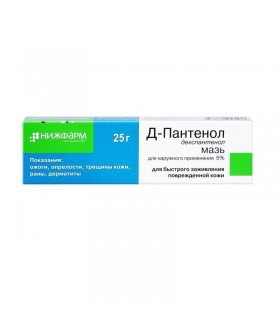




Security policy (edit with Customer reassurance module)

Delivery policy (edit with Customer reassurance module)

Return policy (edit with Customer reassurance module)
Trade name of the drug: D-panthenol
International non-proprietary name: Dexpanthenol
Dosage Form: ointment for external use
1 g ointment contains
The active substance is dexpanthenol 50.0 mg.
Excipients: phenonip - 4.0 mg, lanolin - 160.0 mg,
white beeswax - 50.0 mg, white paraffin soft - 210.8 mg,
Dimethicone - 5.0 mg, emulsifier LANETTE SX - 20.0 mg,
propylene glycol - 20.0 mg, butylhydroxyanisol - 0.1 mg,
butylhydroxytoluene - 0.1 mg, decamethylcyclopentasiloxane -
20.0 mg, Magnesium sulfate heptahydrate - 5.0 mg, protegin B -
295.0 mg, purified water - 160.0 mg.
Uniform ointment of light yellow color with a characteristic smell of lanolin.
Reparation tissue stimulator.
Dexpanthenol is a derivative of pantothenic acid. In the body it is metabolized to pantothenic acid, which is an integral part of coenzyme A and is involved in the processes of acetylation, carbohydrate and fat metabolism, in the synthesis of acetylcholine, glucocorticosteroids, porphyrins; stimulates skin regeneration, normalizes cellular metabolism, accelerates mitosis and increases the strength of collagen fibers. It has a regenerating, metabolic and weak anti-inflammatory effect. An increase in the demand for pantothenic acid is observed when the skin or tissues are damaged, and its deficiency can be compensated for by the local use of D-Panthenol. Optimum molecular weight, hydrophilicity and low polarity make it possible to penetrate into all layers of the skin.
Pharmacokinetics: when applied topically, it is rapidly absorbed and converted into pantothenic acid, binds to plasma proteins (mainly beta-globulin and albumin).
- dry skin;
- wounds and burns of various origin (including solar), scratches, abrasions;
- bedsores, poorly engrained skin grafts, aseptic postoperative wounds, skin care around tracheostomy, gastrostomy and colostomy;
- dermatitis, boils after opening and sanation, trophic ulcers of the lower extremities;
- treatment and prevention of cracks and inflammation of the nipples of the breast during lactation;
- treatment and prevention of the effects of adverse effects on the skin of environmental factors (cold, wind, dampness);
- care for infants: • prevention and treatment of diaper rash in infants; • activation of the skin healing process for minor injuries, diaper dermatitis, erythema from diapers, scratches and slight irritation after exposure to the sun, ultraviolet and x-rays.
Hypersensitivity to one of the components of the drug.
Outwardly. The ointment is applied to the affected skin 1 or several times a day if indicated. Apply a thin layer to the affected skin, gently rubbing. Breastfeeding mothers ointment the infected nipple surface after breastfeeding. Ointment is also used in children, including newborns. For infants, the drug is used after a change of linen or water treatment.
Treatment of trophic ulcers and poorly healing skin grafts should be carried out under the supervision of the attending physician. Do not apply on weeping wounds.
Cases of overdose are not marked.
Side effects are extremely rare.
There may be slightly pronounced allergic reactions.
The interaction of D-Panthenol ointment with other drugs for external use is not installed.
D-Panthenol topical ointment can be used during pregnancy and lactation.
The drug does not affect the ability to drive vehicles and mechanisms.
Ointment for external use. On 25 g, 50 g of a preparation in the aluminum tuba covered twice with a protective varnish, with the soldered opening and a plastic cap. The tub together with the instructions for use are placed in a cardboard box
At a temperature not exceeding 25 ° C in the reach of children.
Shelf life:
2 years. Do not use after expiration date.
Pharmacy sales conditions:
Over the counter.